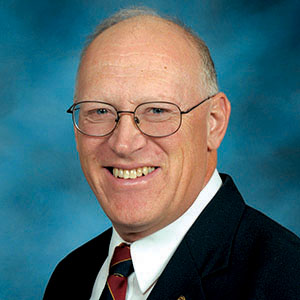Kansas Profile – Now That’s Rural: Fern Bartel, Mennonite Museum
At a glance: After volunteering on the board of the Mennonite Heritage and Agricultural Museum in Goessel for 15 years, Fern Bartel became director in 2017. In 2024, the museum and the Goessel community are celebrating 150 years since their Mennonite ancestors brought Turkey Red winter wheat to Kansas.
More information: Ron Wilson, rwilson@ksu.edu, 785-532-7690
Photos: Ron Wilson | Fern Bartel
Website: Huck Boyd National Institute for Rural Development
June 26, 2024

By Ron Wilson, director of the Huck Boyd National Institute for Rural Development at Kansas State University
What do you take with you when you travel? A suitcase? Extra clothes? A book to read?
Today we’ll learn about a group of people who traveled halfway around the globe to Kansas 150 years ago. They brought with them something that would change the history of Kansas and the nation. I’m referring to the Mennonite families who brought with them Turkey Red wheat.
![]() Fern Bartel is director of the Mennonite Heritage and Agricultural Museum in Goessel, Kansas. Bartel grew up at Goessel, attended Emporia State and met and married her husband. She enjoys art and volunteered on the board of the Mennonite Heritage and Agricultural Museum for 15 years before becoming director in 2017.
Fern Bartel is director of the Mennonite Heritage and Agricultural Museum in Goessel, Kansas. Bartel grew up at Goessel, attended Emporia State and met and married her husband. She enjoys art and volunteered on the board of the Mennonite Heritage and Agricultural Museum for 15 years before becoming director in 2017.
At left: Fern Bartel | Download this photo
2024 is a special year in Goessel. It was 150 years ago that Mennonite families on the plains of Ukraine emigrated to the plains of Kansas. Fifty years ago, on the centennial of that migration, Goessel dedicated a new museum to share that story. The museum has now grown into eight buildings in a village-like setting.
In 1874, Mennonite farmers and their families in southern Russia chose to migrate because their religious freedoms were being curtailed by the government. The Santa Fe Railroad recruited them to come to the central plains of the United States, and built barracks-like structures called Immigrant Houses as temporary housing for the arriving families.
Many Mennonites made the journey and settled in southcentral Kansas. They brought with them seeds of Turkey Red winter wheat in large jars and sacks.
This variety of wheat would prove well-suited to the Kansas climate. According to the Kansas Wheat Commission, its introduction “revolutionized the wheat industry in Kansas, and Turkey Red wheat is now the ancestor to all hard red winter wheat varieties grown across the plains today.”
Alexanderwohl was the name of one of the southern Russian villages from which some of the Mennonites came. When immigrant houses were built here, a church that carried the village name was built nearby. The Alexanderwohl Mennonite Church is still active in Goessel today.
The city was named after Captain Kurt von Goessel who went down with his ship after it was rammed in the English Channel.
Almost all of the original population of Goessel was Mennonite. After the Mennonite Heritage and Agricultural Museum was established, it came to include many display cases that traced the lineage and descendants of the first settlers.
The first building to be included in the museum complex was the Goessel Preparatory School, which was constructed in 1906. In later years, it served as the high school’s industrial arts classroom until the 1970s. The proposed demise of this building sparked the idea of a museum and led to the building being moved to its current site. A replica of a railroad Immigrant House also was constructed.
A new building constructed in 1974 was called the Turkey Red Wheat Palace. That includes a large variety of antique farm equipment plus the Wheat Straw Liberty Bell. This is a giant replica of the Liberty Bell, constructed of wheat and straw over wire and tubing. It was commissioned by the Smithsonian Institute and built by the Mennonites at Goessel to commemorate the nation’s bicentennial.
The bell is eight and a half feet tall and accurate in every detail. The body is straw and the crack is marked by wheat berries outlined by black thread.
Other buildings added to the complex and their years of construction include the 1902 Schroeder Barn, the 1911 Friesen House, the 1910 Goessel State Bank, the 1875 South Bloomfield School, and the 1875 Krause House. The museum has drawn visitors from across the nation and beyond.
It’s a remarkable resource to be found in a rural community such as Goessel, population 556 people. Now, that’s rural.
For more information, see www.goesselmuseum.com.
What do you take with you when you travel? We’re so thankful that these Mennonite families brought Turkey Red Wheat with them, and we’re grateful that Fern Bartel and others are making a difference by preserving and sharing this heritage. For modern-day visitors, it is worth the travel.
Audio and text files of Kansas Profiles are available at http://www.kansasprofile.com. For more information about the Huck Boyd Institute, interested persons can visit http://www.huckboydinstitute.org.
***

K‑State Research and Extension is a short name for the Kansas State University Agricultural Experiment Station and Cooperative Extension Service, a program designed to generate and distribute useful knowledge for the well‑being of Kansans. Supported by county, state, federal and private funds, the program has county extension offices, experiment fields, area extension offices and regional research centers statewide. Its headquarters is on the K‑State campus in Manhattan. For more information, visit www.ksre.ksu.edu. K-State Research and Extension is an equal opportunity provider and employer.